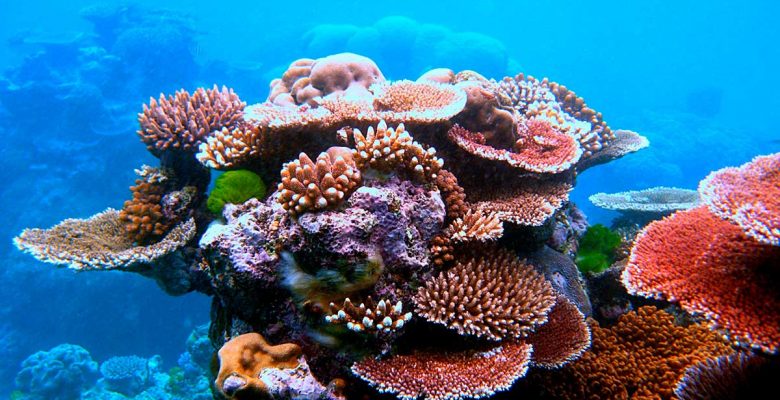By Laurie Henry
Recognition of the endangered heritage of the Great Barrier Reef is great news for the sustainability of coral reefs around the world. Findings are accumulating concerning the degradation of marine and terrestrial biodiversity, but all scientists agree that action must follow, especially since we still have the means to act to prevent the total disappearance of corals.
Coral reef biologist and climatologist Professor Ove Hoegh-Guldberg of the University of Queensland in Australia was among the first to sound the alarm about the threat that warming and acidification of the oceans pose to marine ecosystems, following his pioneering research on coral bleaching and mortality.
Regarding the state of coral reefs around the world, the scientific observation is clear: they have all regressed over the past few decades. The trajectory that our societies are taking vis-à-vis climate change and global warming does not leave these ecosystems a chance. With an increased temperature of 2.5°C, 99% of corals will disappear.
But the time for finding out is over, say the researchers unanimously. The means of action are known and the avenues of hope exist.
Allocation of world heritage status to coral reefs in the Gulf of Aqaba
According to the Professor Ove Hoegh-Guldberg, even if the actions are still few, the implementation of stronger protective measures would allow a new breath, as for the Gulf of Aqaba or the Grande Barrier de Corail. His study, recently published in the Journal Frontiers and entitled “The reefs of the hope of the Gulf of Aqaba: allocation of world heritage status to coral reefs of the Gulf of Aqaba, north of the Red Sea”, was conducted jointly with academics from Jordan, Germany, Australia, Monaco, Switzerland, and Israel.
The coral reefs of the Red Sea are indeed a rich source of food, means of subsistence, coastal protection and natural products, and bring millions of people to life bordering the sea. According to this study, “the highly biodiversity coral reefs of this site in the North Red Sea have unique resilience to global warming, which could be the key to preserving the corals of the earth while the temperatures of the oceans continue to warm up”.
However, the future of this region is threatened not only by climate change, but also by pollution, coastal development and overfishing. Coral reefs and marine life are not subject to political borders. Urgent conservation efforts are necessary for regional and national levels, to secure unique coral reefs and resistant to the Gulf temperature and their interdependent ecosystems (for future generations).
To fulfill this cross -border conservation effort, the authors propose that the region of the Gulf of Aqaba, including some of the coastal waters of Jordan, Israel, Egypt and Saudi Arabia, be included on the list UNESCO World Heritage Sites. Just like the great barrier of coral.
The great barrier of coral soon on the UNESCO World Heritage List
To the northeast of the Australian coast, the largest coral ensemble in the world offers, with its 400 species of corals, its 1,500 species of fish and its 4,000 species of mollusks, a spectacle of a variety and a beauty extraordinary and high scientific interest. It is also the habitat of endangered species, such as the Dugong and the Great Green Turtle.
The UNESCO World Heritage List of UNESCO is designed to inform the international community of conditions that threaten the very characteristics for which good has been registered on the World Heritage List, and to encourage corrective measures.
In July 2021, the World Heritage Committee asked Australia to submit an updated report on the reef conservation state and to invite an expert surveillance mission to visit the reef and assess its state of conservation.
At the end of this mission, the UN concluded that the largest coral reef system in the world should be placed on a list of world heritage sites in danger. More specifically, climate change presents a “serious challenge” to the values that saw the reef inscribed as a worldwide wonder in 1981.
Progress to reduce pollution of reef waters by agriculture and pasture is too slow and more investments are necessary to achieve water quality objectives, according to the mission report.
Need for actions against climate change
Putting environments under protection is the first step to preserve them especially when it comes to refuge areas, resilient in the face of climate change.
A new study (A. Greiner et al., 2022) of the Wildlife Conservation Society (WCS) of the University of Toronto and the National Research Council of Italy, highlighted the “hope spots” of coral reefs in the world. The results show that climate-resistant reefs are connected to invisible submarine networks connected by tiny larval corals that move from one reef to the other on ocean currents. These networks have the ability to survive and reset the ocean biodiversity, even after mass laundering events provided for in climate change.
Ariel Greiner, doctoral student at the University of Toronto and first author, declares in a press release: “Our results show how crucial it is to understand the networks of coral reefs and how they can be affected by climate change, during the Design of future conservation strategies for coral reefs”.
She concludes: “In particular, this study reveals that these networks of coral reefs can help maintain the bastions of coral reefs and that additional ‘spring’ ” spring ‘reefs, reefs which serve as lands of larvae between the bastions of coral reefs, will be necessary to preserve the rest of the world habitat of coral reef”.


